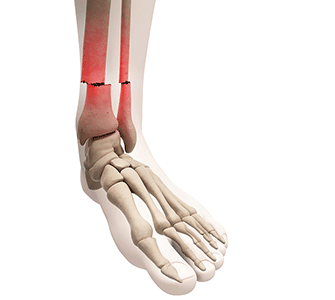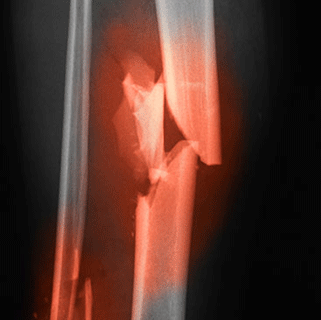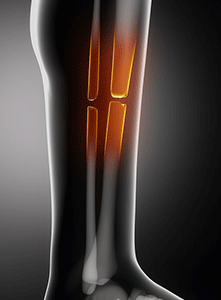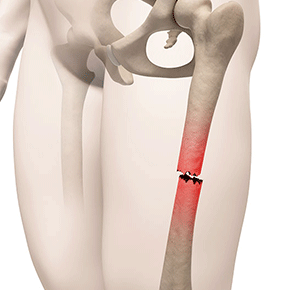
Cilliers & Swart physiotherapists work with a network of orthopaedic surgeons. Our aim is treating fractures (for example a collar bone injury) conservatively before surgical intervention is necessary. Most fractures occur from direct trauma – whether you fracture your arm, leg or ribs. In cases where you are unsure, we (physiotherapists) examine you to determine if a bone is cracked, broken or splintered. There are different types of fractures that need to be considered. As a result, we refer you for x-rays, sonar or other investigative methods to confirm your fractured bone’s diagnosis.
If your diagnosis is confirmed, please remember to bring all scan, tests, or previous x-rays along to your treatment session.
Each person’s case is unique and we want to address your specific needs. If you would like us to investigate or provide some insight, we invite you to contact us by clicking the link below.
Get to the root cause of your problem
Our team of experts guide you to heal
Healing period for a bone fracture
The amount of time it takes for a bone fracture to heal can be affected by various factors. You can expect an upper limp to heal in 6 to 12 weeks, and a lower limb to heal in 12 to 16 weeks.
* These times are a general rule of thumb, we are working on providing you with more detailed breakdown.

Why physio after breaking a bone?
Physiotherapists have experience in treating bone fractures. A physio can tell you what to do during recovery and what to avoid. We guide you through the recovery process – from addressing the initial pain, to helping you go back to your daily routine.
Collar bone fractures
The clavicle (collarbone) makes up part of the shoulder, and helps to keep the shoulder blade in the correct position. Fractures of the collarbone, while serious in themselves, also result in damage to the nerves and blood supply in the neck and shoulder. The clavicle is a curved bone that attaches the sternum (breastbone) at one end, and the scapula (shoulder bone) at the other. Much of the clavicle bone is protected only by skin making it highly susceptible to injury.
Causes
Fractured collarbones are common in sports where a person falls onto their shoulder or experience frequent blows to the collarbone. For example, a person falling from a bicycle landing directly onto their shoulder or even onto an outstretched arm. Another example is players colliding during contact sports such as rugby. In both examples, the impact puts the collarbone under great pressure. The cracking or breaking apart of the bone comes as a result of a weakness along the bone which cannot take the pressure.
Symptoms
You will in most cases feel immediate pain along the length of your collar bone. You will see and feel swelling as a firm lump forms around the fracture, especially if the bone ends are broken or moving apart form each other. Noticing redness and bruising around the injury is also common. Lifting your arm (forwards or sideways) will be extremely painful and you may need to support it with your opposite arm. Experiencing pins and needles in your arm and hand can happen sometimes.
Diagnosis
A physiotherapist makes a diagnosis through a physical examination. The size and location of the bone fracture is confirmed with an X-ray.
Risks and Complications
When a fractured bone is badly displaced, the bone may fail to fuse properly while healing. When this happens it leads to an abnormal shoulder position resulting in chronic problems. However this is very rare. Allowing enough time for a fracture to heal reduces the risk of developing osteoarthritis in your shoulder joint.

Return to sport
Resuming contact sports or activities with over-the-head arm movement usually happens after 12 weeks in most cases. Cilliers & Swart physiotherapists understand each individual case is different. As a general rule, healing a fractured clavicle is quicker if you opt for surgical repair.
Things you can do if you think you fractured your collarbone:
- Following the PRICE procedure
- Putting your arm in a supportive sling
- Call us to book an appointment to evaluate the damage
Undisplaced Fracture of the Collarbone
An undisplaced fracture is when the related bones are not separated from each other. A physiotherapist usually recommends pain relieving medication for a diagnosed undisplaced fracture. Following the rehabilitation program with your physiotherapist helps restore your shoulder joint’s normal mobility.
Displaced Fracture
A displaced fracture happens when the related bones (or segments of the same bone) separate from each other. A physiotherapist usually recommends surgery for a diagnosed displaced fracture. During surgery the ends of the bones (or segments of bones) are realign. For surgery you can expect a referral to a Shoulder Orthopedic Surgeon.
Physiotherapy treatment
Early stage
Generally a physiotherapist recommends putting your arm in a sling for 3 to 6 weeks. During this time additional treatments such as electrotherapy will be used for reducing local inflammation. We recommend using low-intensity pulsed ultrasound to help the healing of the bone.
We will take your shoulder through a series of movements (within pain limits) to assess the range of movement in the joint. Assessments involve no effort from you because the movements are done passively (Passive Range of movement). During recovering you will be able to initiate these movements yourself (Active range of movement). At each physiotherapy session the consulting physiotherapist will reassess and monitor your range of movements to confirm your improvement.
Performing exercises to promote the control of your shoulder blade (as the pain allows) are part of standard treatments. Additional exercises using resistance without joint movement (e.g. shoulder isometrics) also help you in strengthening your shoulder, elbow and wrist.
Intermediate phase
Your physiotherapist guides you through:
- Demonstrating that no swelling is visible around the shoulder or collarbone.
- Showing a full range of motion in your fingers, hand, wrist, elbow and shoulder.
- Putting your full weight on your shoulder with minimal pain.
When assessing your grip strength, the physiotherapist ensures that your injured arm is only 10% less capable in performing movements compared to your uninjured arm. Additionally, the physiotherapist assesses the muscle function on your shoulder in all directions. A sign of a good recovery is when the side of the injured shoulder is only 10% less capable compared to the uninjured side.
Surgery
After surgery a doctor usually recommends putting your arm in a sling for a period of 3 to 6 weeks. In the course of the 3 to 6 week period your doctor will likely take additional X-rays to confirm that your shoulder is healing as expected. However, in most cases X-rays are only taken after 6 weeks. Typically at this point in time, your Orthopaedic surgeon will refer you to a physiotherapist. The physiotherapist assists in drawing up a rehabilitation program for you to help restore the normal movement of your shoulder joint. The physiotherapist continually monitors your progress through the rehabilitation program while sicking to any instructions provided by your Orthopaedic surgeon.
A cautionary Tale
A man was given a sling for his arm after he fractured it. The man heard the doctor say: “Keep the sling on for 6 months.” The man nodded without asking any questions. True to his word, he kept the sling on his arm for 6 months. Never taking it off to wash, sleep, eat, etc. After six months the man took off the sling. To his horror his arm was now stuck in a sling position.
The same man arrived at our practice. We figured out that he has misheard the doctor. The doctor had instructed “6 weeks…” Through physiotherapy we rehabilitated the muscles for the man to straighten his arm. It took him 1 year to straighten his arm and exercise enough force to push open a door with his arm.
Tip to improve healing
Exercise as instructed by your physiotherapist. Performing a physical activity gets your heart pumping more nutrient rich blood. Exercising increases your blood circulation which means more nutrient rich blood will circulate around the affected area and in turn help speed up recovery.
Get the help you really need
Medical professionals that care about you
I think I broke my leg
When speaking to a medical professional it is common to use the term ‘broken leg’. This term describes a fracture of any of the three bones which form the leg. The Tibia bone and Fibula bone in the lower leg are more commonly injured than the Femur (thigh) bone.
Femur fracture
A Femur fracture refers to the fracturing of the Femur (thigh) bone. It is rare for a thigh bone to fracture and is usually the result of a car accident. People are more likely to develop stress fractures, especially among athletes. A Femur fracture typically takes more time to heal compared to other leg fractures because of the bone’s poor blood supply.
Fibula fracture
The Fibula is the smaller bone of the lower leg. Its function is to provide attachments for the muscles of the lower leg. Fibula fractures occur as a result of direct trauma or through a stress fracture.

SKILLED EXPERIENCED MEDICAL PROFESSIONALS
“Long lasting pain needs a solution.
Start your treatment today and avoid surgery”
If you’re suffering from pain after trauma or even surgery, you are at the right place. We treat all kinds of injuries and damaged tissue like muscle, joint, tendon, ligament, and nerves. Sign up for treatment today.
Treatment
If you suspect you’ve broken a bone, you should seek medical attention immediately. Taking an X-ray confirms the injury and determines the extent of the damage. It is important that the doctor check that there are no additional injuries to the nerves or blood vessels in the area. Simple checks for sensation and pulse can do this. In most cases a plaster cast is applied to the leg to immobilize the bones whilst they heal.
This is usually worn for 6-8 weeks. In cases where the bone has broken into more than one piece, or when the fracture is open or displaced, surgery may be required. Surgery is used to bring the bones back together and hold them in place with pins or wires. The leg is then placed in a cast. After the cast is removed, the patient should follow a rehabilitation program to regain full strength and movement in the leg.


